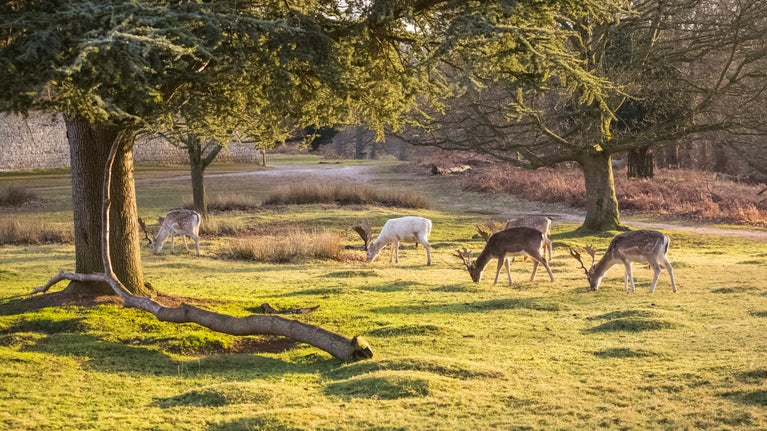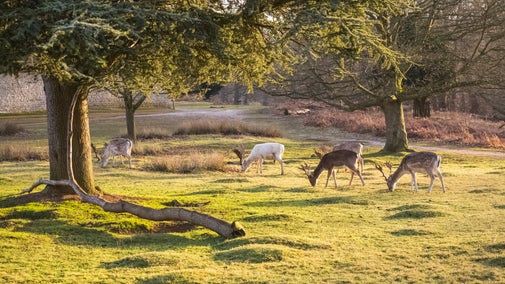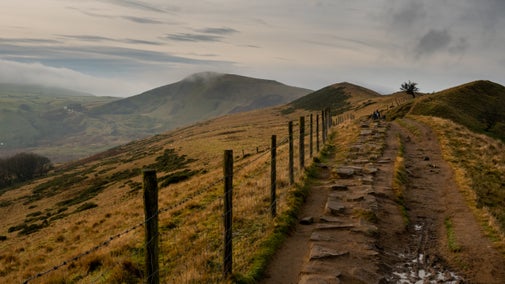
Donate
Everyone needs nature, now more than ever. Donate today and you could help people and nature to thrive at the places we care for.

Covering 1,000 acres of trees, woodland, valleys and parkland, Knole Park is a tranquil haven of wildlife in the middle of Sevenoaks. Pick a walking route to follow as you explore the veteran trees and hunt for wildlife in this Site of Special Scientific Interest. Look out for the volunteer deer rangers when you’re out and about; they’re full of interesting facts.
The deer in Knole Park are wild animals. Please don't approach, touch or feed them and remember to always view the deer from a distance. Please keep dogs on a lead at all times. Thank you.
Foraging of any kind is not permitted in Knole Park. All flora and fauna is there to sustain the deer and create the natural habitat which is the SSSI. The land and all that grows on it is privately owned and protected by Natural England.
The Archbishop of Canterbury, Thomas Bourchier, acquired Knole in 1456 and turned an old hunting lodge into a grand palace alongside establishing the deer park. Parts of his palace are still visible today and the deer have remained at Knole ever since.
Tree-lined avenues cross the park and provide today’s grand walkways. Dendrochronology has shown that the oldest trees in the park date to the early 1700s, and some of these veterans can be found in Chestnut Walk, Broad Walk and Duchess Walk. The golf course was laid out in 1923.
A visit to the park wouldn't be complete without a sighting of some of Knole’s famous fallow deer.
These wild animals might well be inquisitive and appear tame but please don’t encourage them to approach you or interact with them. They can be aggressive, carry ticks and diseases and are best observed from a safe distance. Feeding them makes them more likely to attack. They get all the natural food they need from the park, supplemented by the Deer Keeper when needed.
The deer rut takes place in autumn, when the bucks will fight for the does. This can be impressive to watch but remember to keep a safe distance. When the deer are holding their stands they do not want people near them.
The Sackville family's Knole Estate owns and manages the vast majority of Knole Park as well as the wild deer herd in the parkland. The National Trust owns and looks after the parkland from the front of the house up to the main entrance.

There are many areas of Knole Park to explore, from its wooded uplands, dry river valleys, tree-lined avenues and majestic Gallops to far-flung corners of secluded woodland.
If you’re not sure where to start exploring or don’t know Knole Park very well, why not try one of the suggested walking routes? These colour coded routes start from the front of the house and range from 4-5km each. They are sign-posted and take 50-75 minutes to complete. They are mainly across rough, undulating ground, so not suited to those with mobility issues. The red walk is best suited for visitors with sturdy pushchairs. These routes have been agreed with the park’s landowner, Knole Estate, and follow routes safely away from the golf course. For those looking for a route on hard-standing paths in the park, there are a few options but many of these cross the golf course so please take care if using them.
Take a look at the maps displayed outside the Brewhouse Café and by the picnic area before you set off to choose a path that suits you. Alternatively, you can download a map here or call in to the visitor centre to ask for advice.
Members of the public are also able to explore access routes through land owned by the Sackville family’s Knole Estate beyond the boundary of Knole Park. There are footpaths, bridleways and common land through woodland stretching out towards Godden Green and Stone Street.
If you choose to cycle here please take care around other visitors, vehicles, horses and wildlife that also use the paths and tracks. Some of the pathways also cross the golf course, so please keep your bike on the paths in this area. If you’re in need of refreshments, there is a cycle rack by the picnic area, close to the Brewhouse Café.
Thank you for your co-operation. If you have any enquiries regarding filming, photography and drone use, please email knole@nationaltrust.org.uk

Knole Park is a thriving habitat for the diverse wildlife that live here, and is a designated SSSI. Across the park there’s acidic grassland, parkland, woodland and ponds, each home to a range of flora and fungi, as well as a variety of rare invertebrates.
In October 1987 the Great Storm tore through Kent and Knole’s landscape fundamentally changed overnight. Most of the trees that fell were left as deadwood, which has had significant benefits for fungi, plants and wildlife over the following years, as well as the trees that grew to replace them. You can still see remnants of the devastation in areas of the park today.
In the park you can see many horse chestnut, sweet chestnut, English oak, hawthorn and beech trees among other more unusual finds such as red oak and yew. Many of these are very old, known as veteran trees, and it is these that provide excellent habitats for Knole’s wildlife, lichen and fungi.
Lots of work is carried out to protect these veteran trees as they eventually become the next source of deadwood, which is essential in helping the wildlife at Knole to continue to thrive.
Across the acidic grassland of the park there are areas covered with hundreds of ant hills. These were made by the intrepid yellow meadow ant with each hill containing between 8,000 and 14,000 ants. This species of ant has been a resident at Knole for centuries and these ‘ant villages’ are park institutions. Keep an eye out for green woodpeckers feeding on the hills.
Knole is home to numerous invertebrate species, but it is the deadwood beetles, or saproxylic beetles, that form a large part of why Knole was granted SSSI status.
Minibeast hunters can pass many hours at Knole looking under logs and bark to see the life teaming just under the surface, but what may surprise some is that many species are rare for Kent but not the UK. This is because Knole has a cooler climate than the rest of south-east England leading to species more common in the north-west England making their home here.
Nationally scarce species of fungi can be found living on and under trees and growing on deadwood. As well as providing interesting autumn colour and food, the fungi is essential in the process of rotting down deadwood.
The excellent examples of lichen found on veteran trees around the park and on old walls indicate good air quality and a good variety of species and age of the trees. From the amethyst deceiver and beefsteak fungus to the saffrondrop bonnets and fairy fingers, there are hundreds of fungi to discover.
Across the park and buildings at Knole, you can find many of the UK’s bat species as they use the site to nest, feed and commute. As the park has no lighting, shortly after dusk on a bright summer’s evening it can be easy to spot them darting about looking for insects to eat over the long grass and among the treetops.
While Knole is host to at least nine of the 17 species of bat found in the UK, you will most likely see the soprano pipistrelle, and common pipistrelle, which will eat up to 3,000 tiny insects in one night.

We’ve worked with our partner Forthglade to come up with this Canine Code, which helps to make sure everyone can enjoy their day:

Everyone needs nature, now more than ever. Donate today and you could help people and nature to thrive at the places we care for.
Knole is a two pawprint rated place, with acres of parkland to enjoy with your dog. Here's what you need to know before you set off.

Knole’s parkland is home to a herd of fallow deer and it’s important to us that everyone has the best experience possible, so here are some dos and don’ts.

Walking routes in Knole Park.
Browse the latest seasonal ranges and pick up something to brighten up your home and bookshelves at Knole. Pop into the Brewhouse Café for drinks, savoury snacks and sweet treats.

Knole was built to impress. Come and explore the grandeur of its showrooms, the hidden secrets of the attics and the rooms Eddy Sackville-West called home in the Gatehouse Tower.

All aerial activity above our sites is prohibited unless specific permission is granted, according to an existing byelaw.

Explore some of the finest landscapes in our care on coastal paths, accessible trails, woodland walks and everything in between. Find the best places to walk near you.

From ancient woodland to Iron Age hillforts, the countryside around Kent is ripe for exploring. Discover some of the best spots to get out into fresh air and back to nature.
